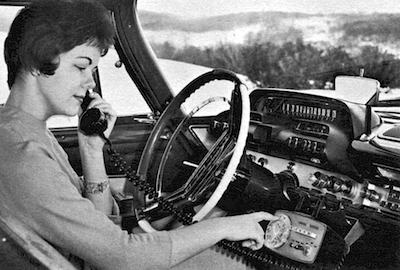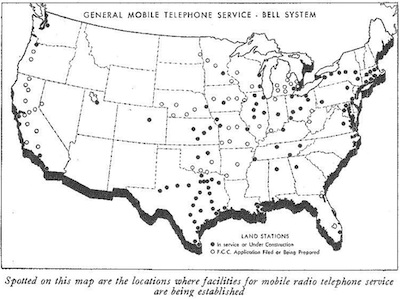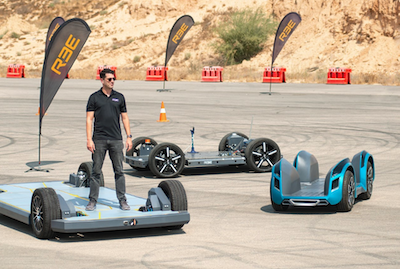Appropriately enough, the first mobile phones were car phones.

Lars Magnus Ericsson (yes, of that Ericsson) developed the first car phone prototype in 1910, which he and his wife used on long drives through rural Sweden. It had a hand-crank and came with two long poles that you attached to nearby telephone wires. It wasn’t very convenient, but it did the job.
I tend to associate car phones with those cheesy “brick phones” from the 1980s, but by the 1940s there were actually several thousand car phone users in the United States, with service in over 60 cities. Calls were placed within a series of isolated “cells” of coverage, powered by remote receivers from Bell Labs hidden at the base of telephone poles:

That’s right — we owe our very first cellular networks to a few thousand 80-pound car phones, most of which were so clunky they had to be housed in car trunks. But today, of course, the mobile device isn’t the phone — it’s the car itself.
General Motors launched the modern concept of the “connected car” when Onstar launched in 1996, but today practically every new vehicle and truck comes with embedded Wi-Fi and telematics. According to Statista, the new consumer services associated with this connectivity constitute a market that is expected to be worth roughly $166 billion by 2025.
People are using embedded Wi-Fi networks in their cars for all kinds of things: playing shows for their kids, finding charging stations for their EVs, getting help in case of accidents. They also make handy hotspots if the power goes out in your house.
And increasingly, automakers are taking advantage of this connectivity to offer an array of à la carte subscription services: music and entertainment options, navigation services, heated seats, voice recognition, parking assistance, enhanced LED headlights. Tesla is offering autonomous driving as a subscription service.
The upside of connected services for automakers are obvious: they get to establish new recurring revenue streams, based on direct relationships with their drivers — relationships that used to be solely owned by dealerships and garages.
What’s the upside for the driver? Well, if you stop looking at your car as a two-ton chunk of metal and rubber that mostly just sits in a driveway all day (and puts you in debt in the process), and more of a digitally-enabled transportation service, then these service options make a lot of sense.
Let’s return to our phone example. Would you like to be forced to pay more for a phone plan with every single potential feature priced in (texting, international, multi-device, multi-family, etc.)? Or would you like to be able to start with a basic package, and then have the option to add more features as you find you need them, or drop them if you don’t?
Personally, I prefer the latter scenario. And when it comes to plug-and-play automobile services, this is where everything is headed.
In the same way we customize our phones and laptops (and increasingly our homes) with apps and functions that we find relevant and useful, we’re going to start customizing our vehicles with services that make sense to us. There’s a word for this: modularity.
The mainstream adoption of electric vehicles (IHS Markit forecasts that by 2023 roughly 43 major auto brands will offer at least one EV option) is only going to accelerate this modularity, and not just in terms of digital services. When you don’t need an engine or a drivetrain, you’ve got a lot more physical space to experiment with.
For example, check out these demo models from an Israeli EV startup called REE (you can see the video here). They look like rectangles on wheels! In fact, they don’t call them vehicles at all; they call them platforms:

REE’s message is clear: here’s something that moves from Point A to Point B, now build whatever you want on top of it. Make it fun, or make it functional. Make it social, or make it individual. Wrap whatever layers of service around it that you see fit.
Feel free to make it your own, but don’t feel obligated to own it. Subscribe to it, the same way you subscribe to a favorite Spotify channel. It’s not a car, it’s a platform.
“The essence of subscription-based business models is that they allow customers to scale; they can flex up, or flex down,” Omar Abbosh, Corporate Vice President of Cross-Industry Solutions at Microsoft, told me. “If you’re an auto player today and you’re trying to deliver a connected vehicle, what are you actually trying to do? You’re trying to offer your customers a suite of services that deliver exactly what they want — no more, no less. They may not sign up for everything on day one, but they’ll have the option to try things out later.”
Cars aren’t dumb bricks anymore. Transportation is becoming a personalized experience. Automobiles are becoming unbundled.
+++
For more insights from Zuora CEO Tien Tzuo, sign up to receive the Subscribed Weekly here. The opinions expressed in the Subscribed Weekly are his own, not those of the company. The companies mentioned in this newsletter are not necessarily Zuora customers.
And check out his book SUBSCRIBED: Why the Subscription Model Will be Your Company’s Future – and What to Do About It.